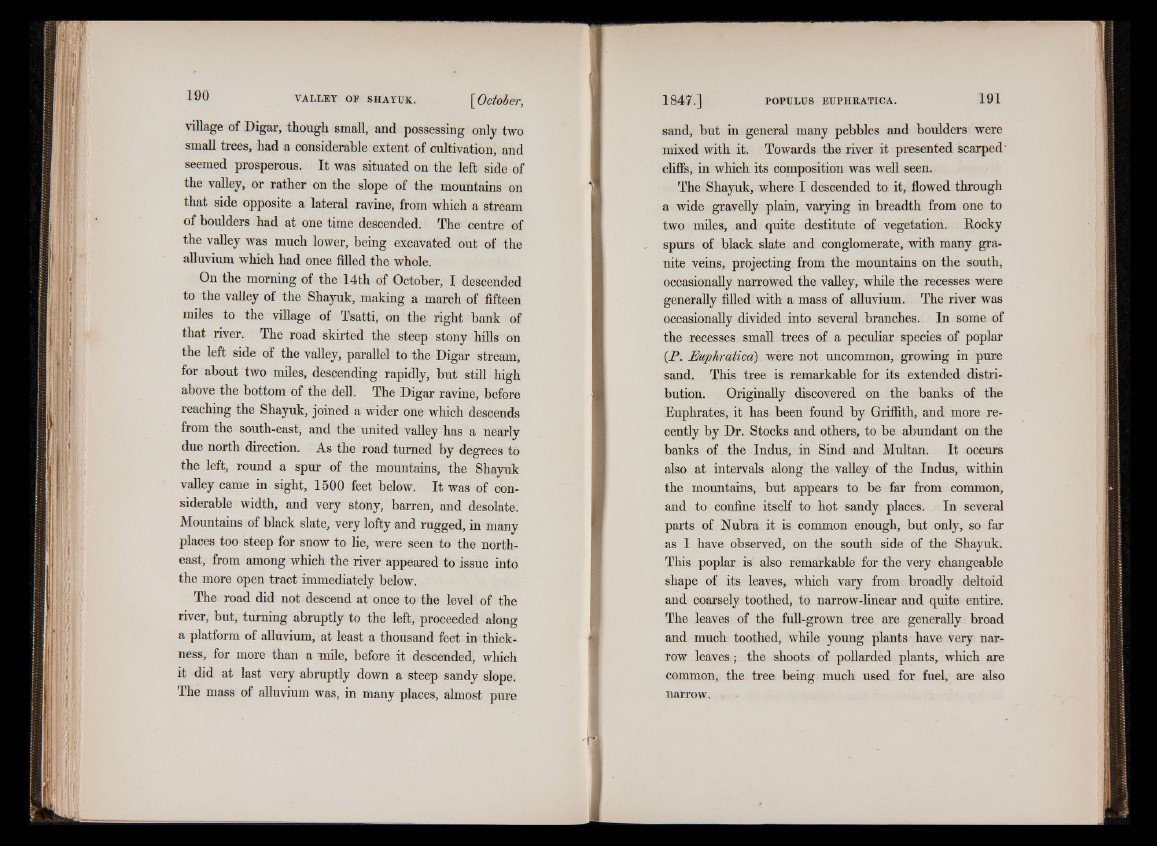
village of Digar, though small, and possessing only two
small trees, had a considerable extent of cultivation, and
seemed prosperous. It was situated on the left side of
the valley, or rather on the slope of the mountains on
that side opposite a lateral ravine, from which a stream
of boulders had at one time descended. The centre of
the valley was much lower, being excavated out of the
alluvium which had once filled thq whole.
On the morning of the 14th of October, I descended
to the valley of the Shayuk, making a march of fifteen
miles to the village of Tsatti, on the right bank of
that river. The road skirted the steep stony hills on
the left side of the valley, parallel to the Digar stream,
for about two miles, descending rapidly, but still high
above the bottom of the dell. The Digar ravine, before
reaching the Shayuk, joined a wider one which descends
from the south-east, and the united valley has a nearly
due north direction. As the road turned by degrees to
the left, round a spur of the mountains, the Shayuk
valley came in sight, 1500 feet below. It was of considerable
width, and very stony, barren, and desolate.
Mountains of black slate, very lofty and rugged, in many
places too steep for snow to lie, were seen to the northeast,
from among which the river appeared to issue into
the more open tract immediately below.
The road did not descend at once to the level of the
river, but, turning abruptly to the left, proceeded along
a platform of alluvium, at least a thousand feet in thickness,
for more than a mile, before it descended, which
it did at last very abruptly down a steep sandy slope.
The mass of alluvium was, in many places, almost pure
sand, but in general many pebbles and boulders were
mixed with it. Towards the river it presented scarped-
cliffs, in which its composition was well seen.
The Shayuk, where I descended to it, flowed through
a wide gravelly plain, varying in breadth from one to
two miles, and quite destitute of vegetation. Rocky
spurs of black slate and conglomerate, with many granite
veins, projecting from the mountains on the south,
occasionally narrowed the valley, while the recesses were
generally filled with a mass of alluvium. The river was
occasionally divided into several branches. In some of
the recesses small trees of a peculiar species of poplar
(P. JEwphratica) were not uncommon, growing in pure
sand. This tree is remarkable for its extended distribution.
Originally discovered on the banks of the
Euphrates, it has been found by Griffith, and more recently
by Dr. Stocks and others, to be abundant on the
banks of the Indus, in Sind and Multan. It occurs
also at intervals along the valley of the Indus, within
the mountains, but appears to be far from common,
and to confine itself to hot sandy places. In several
parts of Nubra it is common enough, but only, so far
as I have observed, on the south side of the Shayuk.
This poplar is also remarkable for the very changeable
shape of its leaves, which vary from broadly deltoid
and coarsely toothed, to narrow-linear and quite entire.
The leaves of the full-grown tree are generally broad
and much toothed, while young plants have very narrow
leaves ; the shoots of pollarded plants, which are
common, the tree being much used for fuel, are also
narrow.